Every Trader Needs An Edge
Volume Shapes And Chart Patterns
by Thomas N. Bulkowski
Do volume shapes predict postbreakout performance from chart patterns?
In the second edition of my Encyclopedia Of Chart Patterns, I introduced a concept that I call volume shapes. I reviewed 38,500 chart patterns and catalogued each according to one of five volume shapes: flat, receding, rising, U, and dome, and then measured performance after the breakout. Here, I will examine the various volume shapes and some of the chart patterns, and discuss performance.
VOLUME SHAPES
Flatliners: Figure 1 shows an example of a symmetrical triangle with a flat volume trend. A symmetrical triangle is a chart pattern that sports price action bounded by two converging trendlines. One trendline slopes downward and the other upward. Look for price to touch each trendline at least twice (two individual peaks and two valleys), with prices crossing the pattern plenty of times. You should not see an abundance of white space between the trendlines - that's key. A breakout occurs when price closes outside of the trendline boundary.

FIGURE 1: Exxon mobile corp. (Petroleum (integrated) nyse, xom). Here's a symmetrical triangle with a flat volume shape.
Flat volume is just what it sounds like. Look for a horizontal volume trend but allow the mountain range to appear irregular. You'll see some peaks and valleys, but the overall trend will appear flat.
Flat volume is unusual for symmetrical triangles; it occurs just 1% of the time. Since it is so rare, it's easier to look for other volume shapes first.
Receding volume shape: Figure 2 shows the receding volume shape beneath an ascending triangle. The triangle sports price action bounded by a horizontal trendline on the top and an upsloping one on the bottom. Price peaks and valleys should come close to or touch each trendline at least twice, plus cross the pattern from side to side. Again, if white space predominates, then you have most likely cut off a rounded turn, and it's not a valid ascending triangle. The breakout is upward most often - 70% of the time - in the 1,092 ascending triangles I examined.
Receding volume is higher at the start of the chart pattern than at
the end. Individual volume spikes may obscure the falling trend, but if
you look at the shape that the trees make on the crest of a hill, the trend
should become clear. Once again, however, the receding volume shape is
rare.
...Continued in the August issue of Technical Analysis of STOCKS & COMMODITIES
Excerpted from an article originally published in the August 2005 issue of Technical Analysis of STOCKS & COMMODITIES magazine. All rights reserved. © Copyright 2005, Technical Analysis, Inc.
Return to August 2005 Contents